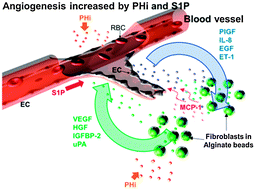Complementary effects of ciclopirox olamine, a prolyl hydroxylase inhibitor and sphingosine 1-phosphate on fibroblasts and endothelial cells in driving capillary sprouting†
Abstract
Capillary sprouting, a key step of neoangiogenesis in wound healing and tumor growth, also represents a therapeutic target for tissue repair. It requires crosstalk between endothelial cells (EC) and other cell types. We studied this process in a microfluidic platform that allows EC to migrate out of a channel across a collagen gel up a gradient of factors produced by a collection of encapsulated fibroblasts. Introduction of a prolyl hydroxylase inhibitor (PHi), ciclopirox olamine (CPX) to stabilize hypoxia inducible factor 1α (HIF-1α) predominantly in fibroblasts induced capillary sprouting in EC, but the most complex tubular networks with true lumina formed after combining CPX with the lysophospholipid sphingosine 1-phosphate (S1P). The enhanced angiogenesis is a possible consequence of the generation of mutually stimulating factors as each cell type responded differently to the compounds. The combination of CPX and S1P induced secretion of vascular endothelial growth factor (VEGF) in fibroblast culture whereas the angiogenic monocyte chemoattractant protein (MCP)-1 was exclusively secreted by fibroblasts, but only in the presence of EC-conditioned medium. Antibody interference with fibroblast-produced VEGF and MCP-1 inhibited the sprouting response. These observations not only demonstrate the collaboration of EC and fibroblasts in inducing capillary sprouting but also suggest that the combination of CPX and S1P enhances angiogenesis and thus might be of therapeutic value for the pharmacological induction of tissue repair and regeneration.


 Please wait while we load your content...
Please wait while we load your content...